
Banksia gardneri, commonly known as prostrate banksia, is a species of prostrate shrub that is endemic to Western Australia. It has pinnatipartite or serrated leaves, usually rusty brown flowers, and up to twenty-five elliptical follicles in each fruiting head. It occurs along the west part of the south coast of the state.

Exacum is a genus of plant in family Gentianaceae. It contains 75 species native to tropical regions of sub-Saharan Africa, southern Arabian Peninsula, south and southeast Asia, New Guinea, and Australia.
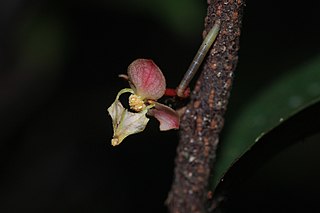
Orophea thomsonii or Thomson's Turret Flower is a species of shrub or small tree in the Annonaceae family. It is native to Kerala and Tamil Nadu in India and endemic to the Western Ghats mountain range.

Syzygium densiflorum is a species of evergreen tree in the family Myrtaceae. It is endemic to the Western Ghats mountains, India. The species is categorised as Vulnerable in the IUCN Red List.
Agasthyavanam Biological Park is a protected area in the Western Ghats in Kerala State, India. The park is located within Vazhichal Panchiyat and lies between the Neyyar and Peppara Wildlife Sanctuaries which covers an area of about 31 square kilometres (12 sq mi).
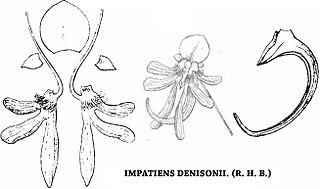
Impatiens denisonii is a scapigerous herb species of the family Balsaminaceae, which is found only in the Western Ghats in South India. It is among the rarest of the eighteen Impatiens species which are endemic to the Nilgiri Hills. It was very abundant and considered among the most beautiful plants in the Nilgiri Hills.

Linum marginale, commonly known as native flax or wild flax, is a species of flowering plant in the family Linaceae and is endemic to Australia. It is a perennial herb with few branches, linear leaves, and blue flowers with five usually blue petals with darker veins.

Persoonia coriacea, commonly known as the leathery-leaf persoonia, is a species of flowering plant in the family Proteaceae and is endemic to the south-west of Western Australia. It is an erect to spreading shrub with smooth bark, spatula-shaped or elliptic to linear leaves and bright yellow flowers borne in groups of up to ten along a rachis up to 70 mm (2.8 in) long.

Diospyros candolleana, is a tree in the Ebony family, endemic to the Western Ghats of India and Sri Lanka. The trees are usually 20m tall, and found as subcanopy trees in wet evergreen forests up to 90m.

Bhesa indica is a flowering plant tree species in the Centroplacaceae family. It is distributed along the tropical wet evergreen forests of the Western Ghats of India. It is considered synonymous with Bhesa paniculata by some authors.

Protosticta gravelyi, the pied reedtail is a damselfly species in the family Platystictidae. It is endemic to Western Ghats in India. It is very widely distributed in hill streams of Western Ghats from Goa to Agasthyamala hills in Thirunelveli district of South India.
Lysiosepalum hexandrum is a species of flowering plant in the family Malvaceae and is endemic to the south-west of Western Australia. It is dense, erect shrub with its young branches covered with woolly, star-shaped hairs, and has linear or narrowly elliptic leaves and blue, purple or pink flowers usually in groups of five.

Myristica beddomei is a species of tree in the family Myristicaceae. It is endemic to the Western Ghats, India, where it is frequent in the mid-elevation wet evergreen forests and an important food tree of hornbills. The species has been earlier misidentified in regional floras and herbarium specimens as Myristica dactyloides Gaertn., the latter occurring only in Sri Lanka.

Cryptocarya anamalayana is a rare rainforest tree endemic to the southern Western Ghats, India. The specific epithet of the name refers to the Anamalai Hills, a major area of its distribution. The species considered endangered under the IUCN Red List of Threatened Species.

Diospyros paniculata, or the panicle-flowered ebony, is a species of tree in the ebony family. Endemic to the Western Ghats area of India and parts of Bangladesh, the species is currently listed as Vulnerable in the IUCN Red List.
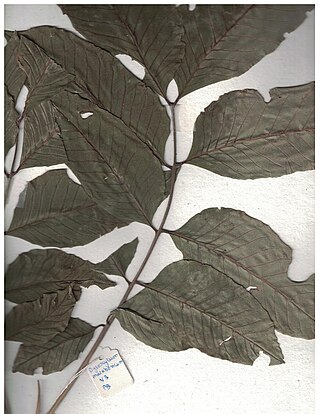
Dysoxylum malabaricum, or white cedar, is a tree species endemic to the Western Ghats, India. The species is considered Endangered under the IUCN Red List of Threatened Species.
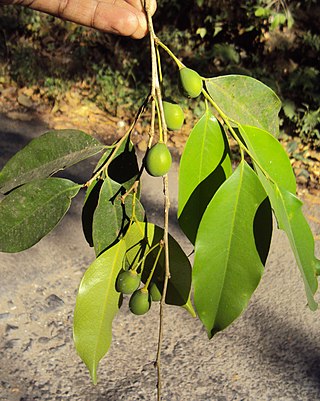
Drypetes venusta is an evergreen tree species endemic to the Western Ghats, India. They are large trees with smooth, straight, and white trunk and horizontal branches. It can reach a height up to 35 m, and a girth up to 3 m.
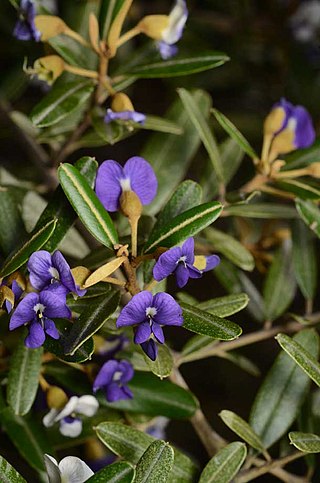
Hovea longipes is a species of flowering plant in the family Fabaceae and is endemic to north-eastern Australia. It is a shrub or tree with narrowly elliptic to lance-shaped leaves, and deep indigo-blue and white, pea-like flowers.
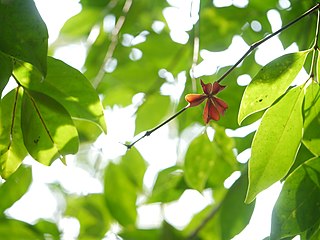
Euonymus indicus, the Indian spindle tree, is a small evergreen understorey tree endemic to the Western Ghats of the Indian peninsula and belongs to the family Celestraceae. It can grow up to a height of 13 m and girth up to 1 m.

Reinwardtiodendron anamalaiense, is a species of flowering plant within the genus Reinwardtiodendron and family Meliaceae. It is an evergreen tree species native to India, where it is endemic to the Western Ghats. It is one of six known species within the genus Reinwardtiodendron.


















